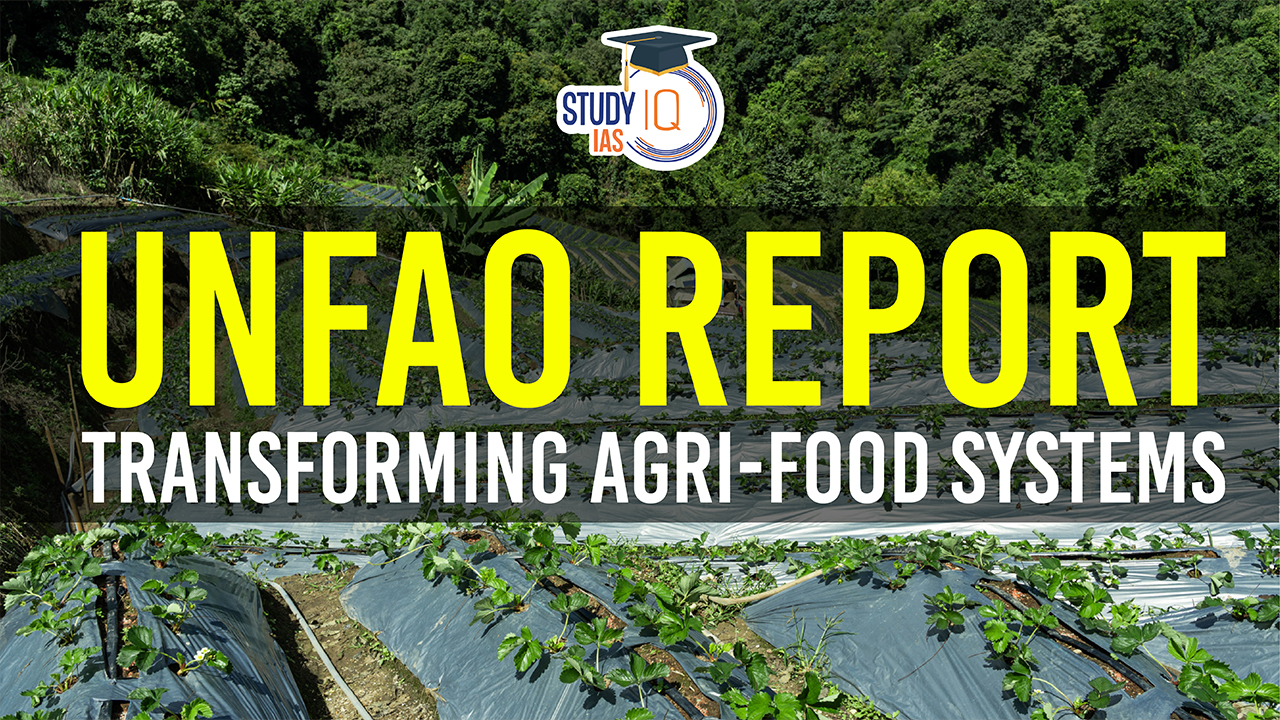Table of Contents
Context: A report by the United Nations Food and Agriculture Organisation (FAO) revealed the enormous hidden expenses of worldwide agrifood systems, exceeding a remarkable $10 trillion.
Key Aspects of the UNFAO Report on Transforming Agri-food Systems
In India
- In countries with middle-level income, such as India, these expenses amount to almost 11% of their GDP.
- This results in increased poverty, environmental degradation, and health issues, including malnutrition and unhealthy eating habits.
- The report attributes these rising costs to “unsustainable standard operations and practices.”
- It emphasises the necessity to overhaul agricultural and food systems, advocating for a transition to multi-cropping systems.
- Such a change could safeguard the welfare of farmers, enhance nutritional benefits for communities, and have a beneficial effect on environmental health.
We’re now on WhatsApp. Click to Join
Unsustainable Standard Operations and Practices
- The impacts of intensive agriculture, particularly in India, are multifaceted and largely detrimental. The shift towards mono-cropping and chemically intensive farming, driven by technological advancements, has had several negative consequences:
- Dependency on HYV Seeds: High Yielding Variety (HYV) seeds, primarily of wheat and paddy, now make up over 70% of India’s agricultural output. This reliance on HYV seeds and chemical fertilisers has eroded seed sovereignty and weakened Indigenous knowledge systems.
- Nutritional Compromise: The focus on these crops has compromised the nutritional diversity of the food supply, moving away from a range of crops like pulses and millets to monocultures.
- Environmental Impact: Intensive agriculture practices have led to ecological disasters, including excessive groundwater extraction and degradation of soil health.
- Financial Burden on Farmers: These practices have also increased the debt burden among agricultural households, as they require significant investment in seeds, chemicals, and water.
- Crop Diversity Decline: There has been a significant shift from diverse crop varieties to monoculture plantations, reducing agricultural biodiversity.
The Impact of Government Policies on Agricultural Diversity in India
- The crops that are being favoured in this system are primarily rice and wheat, largely because these are included in the Public Distribution System (PDS) of the central government.
- The area under cultivation for rice and wheat has increased substantially over the years.
- Additionally, other government-supported crops like sugarcane (which is water-intensive) and arecanut also receive attention.
- However, crops like jowar, bajra, ragi, maize, and barley, which are more sustainable and less resource-intensive, receive much less attention as they constitute less than 1% of total foodgrain procurement.
Benefits of Crop Diversification
- Restoration of Degraded Land and Soil: Crop diversification can play a crucial role in rejuvenating deteriorated land and improving soil health.
- Advantages of Millets: Millets, with yields comparable to rice and wheat, offer several benefits.
- They are nutritious, thrive in semi-arid conditions, reduce groundwater depletion, require minimal inputs, and contribute to a varied diet.
- Multi-Cropping Systems: In Karnataka, the practice known as ‘akkadi saalu’ exemplifies diversified agriculture.
- It involves intercropping various crops like legumes, pulses, oilseeds, along with trees and shrubs.
Transition Strategies for Farmers
- Shifting Farming Practices: Farmers can gradually move from chemical-intensive farming to non-pesticide management and eventually to natural farming methods. This progression can significantly lower input costs.
- Incorporating Livestock and Poultry: Diversification can also include integrating livestock and poultry farming, providing additional income sources and enhancing farm sustainability.
About United Nations Food and Agriculture Organisation (FAO)
| Category | Details |
| Organisation | Food and Agriculture Organization (FAO) |
| Description | A specialised agency of the United Nations focusing on international efforts to defeat hunger. |
| World Food Day | Celebrated annually on October 16 to commemorate the FAO’s founding in 1945. |
| Location |
|
| Initiatives |
|
| Flagship Publications |
|


 SSC MTS Salary 2025, Check Highest Salar...
SSC MTS Salary 2025, Check Highest Salar...
 F-35 Fighter Jet Stranded in Kerala: Dis...
F-35 Fighter Jet Stranded in Kerala: Dis...
 Quad Summit 2025: Key Announcements, Str...
Quad Summit 2025: Key Announcements, Str...





















